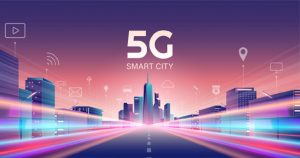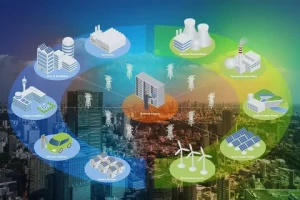As urban populations grow, cities face increasing challenges such as traffic congestion, resource management, and sustainability. Smart cities use advanced technology to address these issues, integrating tools like artificial intelligence (AI), the Internet of Things (IoT), 5G networks, autonomous vehicles, and renewable energy solutions. This technology-driven approach is transforming urban spaces, making them more efficient, sustainable, and livable.
AI and IoT Integration in Smart Cities

Artificial intelligence and the Internet of Things are at the heart of smart cities. These technologies enable cities to collect and analyze vast amounts of data in real time. IoT devices, such as sensors, are installed across urban environments to monitor everything from traffic flow to air quality. AI processes this data, providing insights that city planners can use to improve infrastructure and services.
Benefits:
- Real-time decision-making: Cities can make immediate adjustments to various systems based on real-time data. For example, traffic lights can be altered dynamically to ease congestion, while public transportation schedules can be adjusted based on demand.
- Predictive analytics: AI can analyze historical data to predict future trends, such as spikes in energy usage or traffic surges. This helps cities anticipate problems and address them proactively.
- Enhanced public safety: Smart cities can use AI and IoT to improve security. Surveillance systems equipped with AI can detect suspicious activities, alerting authorities instantly to potential threats.
Example:
In Barcelona, smart streetlights adjust their brightness depending on foot traffic and environmental conditions, reducing energy consumption significantly. This is just one example of how AI and IoT are helping cities become more energy-efficient.
Case Study:
The city of Amsterdam has implemented a traffic management system that uses AI to analyze data from IoT sensors across the city. This system helps reduce traffic congestion by adjusting signals and routes based on real-time conditions. The result is smoother traffic flow and less pollution.
5G Connectivity and Its Role in Smart Cities

The deployment of 5G networks is revolutionizing smart cities by providing faster, more reliable connectivity. 5G’s high-speed, low-latency networks allow for seamless communication between millions of connected devices, enhancing the effectiveness of IoT applications. This allows for more complex and data-intensive services to be integrated into urban environments.
Benefits:
- Faster data transmission: 5G enables the rapid transfer of large amounts of data, which is critical for the real-time operation of IoT devices in smart cities.
- Low-latency communication: 5G’s near-instantaneous communication capabilities allow for the swift execution of actions based on real-time data. This is especially useful in critical applications like emergency response systems or autonomous vehicles.
- Greater connectivity: With 5G, cities can support more connected devices than ever before, from smart sensors to autonomous vehicles, improving overall infrastructure management.
Example:
South Korea’s capital, Seoul, is a leader in 5G implementation, using the technology to enhance public transportation systems and ensure efficient energy use across the city. The city’s 5G-enabled systems allow for real-time monitoring and management of resources, reducing waste and improving service delivery.
Case Study:
Singapore’s smart city initiatives have leveraged 5G technology to create a “digital twin” of the city. This virtual model allows city planners to simulate different urban scenarios, such as the impact of new infrastructure projects or the effects of extreme weather events. By doing so, they can make data-driven decisions that benefit the city’s long-term sustainability and resilience.
Autonomous Vehicles and Smart Transportation Systems
Autonomous vehicles are becoming an integral part of smart city transportation solutions. Self-driving cars, buses, and delivery vehicles offer a glimpse into a future where transportation is safer, more efficient, and less polluting. These vehicles use a combination of AI, sensors, and advanced navigation systems to operate without human intervention.
Benefits:
- Reduced traffic congestion: Autonomous vehicles can communicate with each other and with traffic management systems to optimize routes, reduce delays, and prevent accidents.
- Lower emissions: Autonomous electric vehicles (EVs) contribute to a reduction in greenhouse gas emissions, especially when integrated with smart energy grids.
- Improved safety: Autonomous vehicles reduce the likelihood of accidents caused by human error, making roads safer for everyone.
Example:
In Dubai, autonomous taxis are being trialed as part of the city’s smart transportation strategy. These vehicles use advanced AI algorithms to navigate city streets, offering a glimpse of how autonomous transport could reduce traffic and improve urban mobility.
Case Study:
The city of Dallas is testing autonomous trucks on its highways. These trucks, powered by AI, are designed to improve logistics by optimizing routes and reducing the need for human drivers. By streamlining delivery operations, the city is able to reduce traffic congestion and minimize emissions.
Renewable Energy and Sustainability in Smart Cities

One of the key goals of smart cities is to promote sustainability, and renewable energy is a critical component of this effort. Cities are integrating renewable energy sources such as solar panels and wind turbines into their infrastructure, aiming to reduce their reliance on fossil fuels and lower their carbon footprints.
Benefits:
- Energy efficiency: Smart energy grids allow cities to manage energy consumption more efficiently, ensuring that renewable sources are used to their fullest potential.
- Reduced carbon emissions: By shifting to renewable energy sources, smart cities can significantly reduce their greenhouse gas emissions, contributing to global efforts to combat climate change.
- Resilience: Decentralized energy systems, such as solar panels installed on rooftops, make cities more resilient to power outages and reduce their dependence on centralized energy systems.
Example:
Copenhagen is leading the way in integrating renewable energy into its smart city infrastructure. The city uses wind energy and has implemented smart grids that allow for efficient energy distribution, ensuring that energy consumption is optimized and waste is minimized.
Case Study:
In the city of San Diego, a large-scale smart grid system has been implemented to manage the distribution of renewable energy throughout the city. The system uses AI to forecast energy demand and adjust the supply accordingly, ensuring that energy is not wasted and that renewable sources are used efficiently.
Cybersecurity in Smart Cities

With the rise of interconnected devices in smart cities, cybersecurity is more critical than ever. As more urban systems—such as transportation, energy, and communication—are managed digitally, they become more vulnerable to cyberattacks. Cities are implementing robust cybersecurity protocols to protect sensitive data and ensure the safety of their residents.
Benefits:
- Data protection: Cybersecurity measures help safeguard the vast amounts of data collected by IoT devices, ensuring that personal information is not compromised.
- Infrastructure security: Smart cities rely on critical infrastructure, such as energy grids and transportation networks, that must be protected from cyber threats.
- Enhanced trust: A strong cybersecurity framework fosters public trust in the digital systems that manage essential city services.
Example:
New York City has invested heavily in cybersecurity to protect its critical infrastructure from potential attacks. The city’s cybersecurity initiatives include securing IoT devices and encrypting data to ensure the privacy and safety of its residents.
Case Study:
In Estonia, known as one of the most digitally advanced nations, the city of Tallinn has developed a comprehensive cybersecurity system to protect its digital services. The city uses blockchain technology to secure public records and protect residents’ personal information, setting a global standard for cybersecurity in smart cities.
Conclusion
Smart cities are at the forefront of urban innovation, offering solutions to some of the most pressing challenges of modern urbanization. By integrating AI, IoT, 5G, autonomous vehicles, and renewable energy, smart cities are creating more efficient, sustainable, and livable environments. However, as these technologies advance, challenges like cybersecurity and data privacy must be addressed to ensure that the benefits of smart cities are accessible to all residents. The examples and case studies provided demonstrate how cities around the world are already realizing the potential of smart technologies, paving the way for a more connected and sustainable future.




